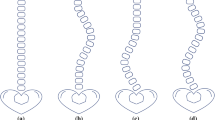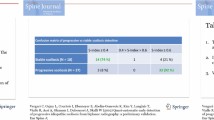Abstract
Choosing the most suitable treatment for scoliosis relies heavily on accurate and reproducible Cobb angle measurement from successive radiographs. The objective is to reduce variability of Cobb angle measurement by reducing user intervention and bias. Custom software to increase automation of the Cobb angle measurement from posteroanterior radiographs was developed using active shape models. Validity and reliability of the automated system against a manual and semiautomated measurement method was conducted by two examiners each performing measurements on three occasions from a test set (N = 22). A training set (N = 47) of radiographs representative of curves seen in a scoliosis clinic was used to train the software to recognize vertebrae from T4 to L4. Images with a maximum Cobb angle between 20° and 50°, excluding surgical cases, were selected for training and test sets. Automated Cobb angles were calculated using best-fit slopes of the detected vertebrae endplates. Intraclass correlation coefficient (ICC) and standard error of measurement (SEM) showed high intraexaminer (ICC > 0.90, SEM 2°–3°) and interexaminer (ICC > 0.82, SEM 2°–4°), but poor intermethod reliability (ICC = 0.30, SEM 8°–9°). The automated method underestimated large curves. The reliability improved (ICC = 0.70, SEM 4°–5°) with exclusion of the four largest curves (>40°) in the test set. The automated method was reliable for moderate-sized curves, and did detect vertebrae in larger curves with a modified training set of larger curves.







Similar content being viewed by others
References
Lonstein JG: Adolescent idiopathic scoliosis. Lancet 344:1407–1412, 1994
Scoliosis Research Society. In Depth Review of Scoliosis. Available at: http://www.srs.org/patients/
Cobb JR: Outline for the study of scoliosis. Am Acad Orthop Surg Inst Course Lect 5:261–275, 1948
Chockalingam N, Dangerfield PH, Giakas G, Cochrane T, Dorgan JC: Computer-assisted Cobb measurement of scoliosis. Eur Spine J 11:353–357, 2002
Loder RT, Spiegel D, Gutknecht S, Kleist K, Ly T, Mehbod A: The assessment of intraobserver and interobserver error in the measurement of noncongenital scoliosis in children ≤10 years of age. Spine 29:2548–2553, 2004
Mior SA, Kopansky-Giles DR, Crowther ER, Wright JG: A comparison of radiographic and electrogoniometric angles in adolescent idiopathic scoliosis. Spine 21:1549–1555, 1996
Cobb JR: Outlines for the study of scoliosis measurements from spinal roentgenograms. Phys Ther 59:764–765, 1948
Rosenfeldt MP, Harding IJ, Hauptfleisch JT, Fairbank JT: A comparison of traditional protractor versus Oxford Cobbometer radiographic measurement—intraobserver measurement variability for Cobb angles. Spine 30:440–443, 2005
Shea KG, Stevens PM, Nelson M, Smith JT, Masters KS, Yandow S: A comparison of manual versus computer-assisted radiographic measurement: Intraobserver measurement variability for Cobb angles. Spine 23:551–555, 1998
Cootes TF, Hill A, Taylor CJ, Haslam J: The use of active shape models for locating structures in medical images. Image Vis Comput 12:355–366, 1994
Cootes TF, Taylor CJ, Lanitis A: Active shape models: Evaluation of a multi-resolution method for improving image search. Proceedings of the British Machine Vision Conference, pp 327–336, 1994
Cootes TF, Taylor CJ, Cooper DH, Graham J: Active shape models—their training and application. Comput Vis Image Underst 61:38–59, 1995
Lindley K: Model based interpretation of lumbar spine radiographs. MSc Thesis, University of Manchester, 1992
Krebs DE: Declare your ICC type [letter]. Phys Ther 66:1431, 1986
Scientific Advisory Committee of the Medical Outcomes Trust: Assessing health status and quality-of-life instruments: Attributes and review criteria. Qual Life Res 11:193–205, 2002
Streiner DL, Norman GR: Health Measurement Scales: A Practical Guide to their Development and Use, 2nd edition. New York, New York: Oxford Medical Publications:106–119, 1995
Acknowledgements
This work was supported by the University Hospital Foundation Medical Research Competition.
Author information
Authors and Affiliations
Corresponding author
Rights and permissions
About this article
Cite this article
Allen, S., Parent, E., Khorasani, M. et al. Validity and Reliability of Active Shape Models for the Estimation of Cobb Angle in Patients with Adolescent Idiopathic Scoliosis. J Digit Imaging 21, 208–218 (2008). https://doi.org/10.1007/s10278-007-9026-7
Published:
Issue Date:
DOI: https://doi.org/10.1007/s10278-007-9026-7




